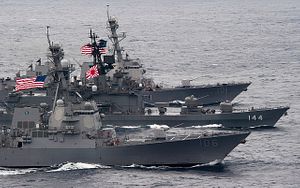During the Second World War, Nicholas Spykman, a professor of international relations at Yale University, wrote two books that explored the fundamental global geopolitical factors underlying U.S. national security, and foresaw a struggle between the U.S. and China for control of what he called the Asian Rimland.
The first book, America’s Strategy in World Politics: The United States and the Balance of Power (1942), was a nearly 500-page tour de force that examined in great detail America’s position in the world “in terms of geography and power politics.” All international politics, Spykman wrote, involved a struggle for power, which “is identical with the struggle for survival, and the improvement of the relative power position becomes the primary objective of the internal and external policy of states.” He analyzed the power position of the United States in the Western Hemisphere, the “Transatlantic” and “Transpacific” zones, and from the perspective of the Old World vs. the New World. He integrated into his analysis economic, demographic and military factors, and concluded that America’s security depended on a favorable balance of power in Europe and the Far East.
In the second, much slimmer book, The Geography of the Peace, published posthumously in 1944, Spykman sketched a geopolitical map that identified the key geographic power centers of the world, including the “Heartland” of Eurasia (H.J. Mackinder’s term for the northern-central core of the Eurasian landmass), the Eurasian Rimland (the crescent-shaped territory abutting the Heartland, which included the countries of Western Europe, the Middle East, Southwest Asia, and the Far East), and North America. In evaluating the power potentials of each key region, Spykman memorably wrote, “Who controls the rimland, rules Eurasia; who rules Eurasia controls the destinies of the world.”
Despite writing when Japan was America’s enemy and China was America’s ally, Spykman foresaw the fundamental geopolitical factors that would result in Japan and China changing places vis-à-vis the United States in the post-war world. “China,” Spykman wrote in 1942, “will be a continental power of huge dimensions in control of a large section of the littoral” of the group of marginal seas that he called the “Asiatic Mediterranean.” He described the Asiatic Mediterranean as “an insular world par excellence,” which is composed of marginal seas such as the Sea of Japan, the East China Sea, and the South China Sea. Those marginal seas control China’s access to the Pacific Ocean and the sea lanes of communication connecting the Indian and Pacific Oceans. He even noted the geopolitical similarity between the Straight of Malacca and the Panama Canal as strategic and commercial passageways and chokepoints in their respective geographic regions.
“A modern, vitalized, and militarized China of 400 million people,” Spykman wrote, “is going to be a threat not only to Japan, but also to the position of the Western Powers in the Asiatic Mediterranean.” He warned that Chinese sea and air power could one day control the “Asiatic Mediterranean,” which is precisely the security threat that is causing tension between China and Japan and lesser regional powers, and is also driving the current U.S. pivot to the Asia-Pacific region. He, therefore, recommended a postwar U.S.-Japanese alliance to restore and preserve the balance of power in the Far East. When Spykman wrote this, it bears remembering, U.S. and Japanese soldiers were killing each other in savage battles in the Pacific.
Two years later in The Geography of the Peace, Spykman unequivocally declared that China would be the dominant power in the Far East after the war and urged U.S. statesmen to establish bases in Japan, the Philippines, and elsewhere from which to project power in the Asiatic Mediterranean to thwart any Chinese attempt to develop overwhelming power in the region. “The United States must recognize once again and permanently,” he wrote, “that the power constellation in . . . Asia is of everlasting concern to her, both in time of war and in time of peace.”
The Asiatic Mediterranean, just as Spykman foresaw more than seventy years ago, has become a geopolitical battleground between China, the United States, Japan, and lesser regional powers. At stake in this struggle are energy resources, economic influence, control of important sea lanes, political control of territory, and the overall balance of power in the Asia-Pacific region.
At the end of The Geography of the Peace, Spykman had one final piece of advice to the American statesmen of his day that should resonate with current and future U.S. leaders. America’s security interests in the Asia-Pacific region and elsewhere will not be protected nor preserved by international institutions or the world community. “We shall continue to depend primarily on our own national strength,” he wrote, “for we know that the failure of a great state to consider power means its eventual destruction and conquest. It has meant the downfall of all the empires that have been tempted by the flabby ease of unpreparedness.”
Francis P. Sempa is the author of Geopolitics: From the Cold War to the 21st Century (Transaction Books) and America’s Global Role: Essays and Reviews on National Security, Geopolitics, and War (University Press of America). He has written articles and reviews on historical and foreign policy topics for Strategic Review, American Diplomacy, Joint Force Quarterly, the University Bookman, the Washington Times, the Claremont Review of Books, and other publications. He is an Assistant U.S. Attorney for the Middle District of Pennsylvania, an adjunct professor of political science at Wilkes University, and a contributing editor to American Diplomacy.

































